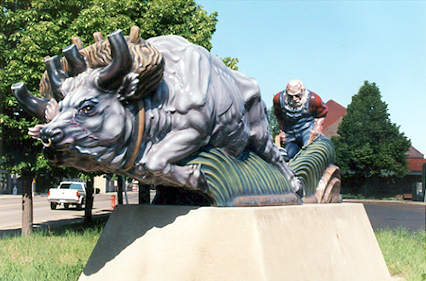The Sodbuster

The Sodbuster by Luis Jimenez stood for 20 years on the east side of the Northern Pacific railroad depot in what was NP Park. The sculpture is made from fiberglass, a non-traditional art medium more often found in the production and repair of boats and cars; however, the sculpture is cast in a traditional art method that uses armatures and molds. After constructing steel armatures in the basic shape of the finished artwork, then casting and attaching the molds together, layers of airbrushed color were applied to make a glossy finish. An epoxy coating was then applied. Standing at approximately 7 feet tall, the Sodbuster toils against nature, muscles straining as he pushes a plow through the earth. Jimenez's art is often compared to works created for the WPA and to paintings by Mexican muralists of the 1930s. In this sculpture his expression of prehistory, due to of greater study of the past, grew. During this time he had found shards of pottery in his own garden and took interest in a Native American burial found near his New Mexican home. This experience was combined with readings of Northern Plains history, community visits and shows at the Fargo museum, and incorporated into "Sodbuster." The piece portrays a stout man guiding an ox drawn plow that not only opens up the soil for planting but exposes buried artifacts, from potsherds to a French Canadian oxcart wheel, of former human habitation. The sculpture was commissioned by the city of Fargo in 1977. Luis Jiménez was selected by a panel consisting of three representatives each from the National Endowment of the Arts and the city of Fargo in 1977. The Fargo Parking Authority received a $20,000 matching grant from the NEA as part of the "Art in Public Places Program." The city donated the sculpture to the Plains Art Museum in 1992 with the agreement the city would cover any moving expenses and the museum would cover maintenance and upkeep. In 2002, the Plains Art Museum commissioned a Minneapolis conservator to assess the condition of the sculpture. The study revealed exposure to the area's extreme elements and proximity to the railroad tracks had not only caused the paint to fade and crack, but also to wear away in some areas to reveal the fiberglass form underneath. In July 2002, after two decades on the corner of Main Avenue and Broadway, wear from the weather had taken its toll, and the sun had faded parts from its painted gray to a purplish hue. The museum removed the sculpture for restoration, and in 2019 it was returned to public view in the city hall plaza.
